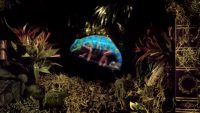Light Field Lab Touts ‘Highest Resolution Holographic Display’
October 14, 2021
Light Field Lab is developing a “naked-eye” holographic technology called SolidLight, which essentially creates high-resolution 3D objects in the real world using light (think the “Star Trek” holodeck or Princess Leia uttering “Help me, Obi-Wan Kenobi” — but better than the actual hologram tech we’ve seen in recent years). “We’re creating a world where content escapes the screen and merges with reality,” claims the Light Field website. SolidLight builds freestanding 3D objects using what the company describes as a “broad-spectrum, complex-amplitude, dense converging wavefront.”
San Jose, California-based Light Field is taking an approach that is simple in concept but ambitious in execution, writes CNET, which explains the process as “causing waves of light to interact at a specific point” of interaction that is visible to the human eye. By doing this at high density, “they can create the illusion of an entire object ‘made’ of light.”

The SolidLight system has three essential components: the display (28-inch diagonal panels capable of configuring as modular video wall panels); computational hardware (including servers, GPUs, synchronization and networking) and the proprietary WaveTracer real-time and offline rendering software and plugins.
VentureBeat reports from a demo involving a chameleon (screen grab above): “It moved a little and stuck its tongue out to zap a fly and the plastic plants moved when that happened,” describing the lizard sim as “a little fuzzy and more pixelated than its surroundings. But it was a 3D object, as I could move my head and see different parts.”
The 28-inch panel has a 10-billion pixel nominal sample density, resulting in a 2.5-billion pixel display. By way of comparison, CNET notes that a 4K TV has 8.2 million pixels. A wall comprised of SolidLight panels could offer more than 245 billion pixels.
These are special pixels, “able to precisely manipulate the phase of the light waves so the interactions of those waves create the holographic effect,” CNET writes. Standard LCD or OLED pixels generate red, green, and blue. SolidLight pixels create specific colors in precise locations in front of the display, allowing the image to “pop” off the screen.
“There still needs to be an imaginary line between your eye and the screen for the hologram to appear in between,” CNET explains. “What makes SolidLight interesting is that you don’t need any special glasses for it to work, nor do you need to be directly in front of the screen. You can still be at an angle, and whatever amount of your eye’s field of view is filled with the SolidLight display, you’ll see the hologram.”
LightField is targeting everyday uses: holographic displays that go from desktop to wall-sized. Desktop functionality would include medicine and industrial design, while interactive holographic walls could be used for advertising, meetings (a high-tech Zoom), lobby displays and, of course, location-based entertainment.
The company is currently building systems for delivery and has already sold-out on pre-orders. In 2019, Light Field raised $35 million from a range of investors, according to Forbes, which says the company has “internationally filed three hundred patents.” Light Field was founded in 2017 by Brendan Bevensee, Ed Ibe and Jon Karafin.
Companies including Microsoft and AV Ventures have developed holographic technology. Live Innovation lists 17 international firms competing in the space.

No Comments Yet
You can be the first to comment!
Sorry, comments for this entry are closed at this time.